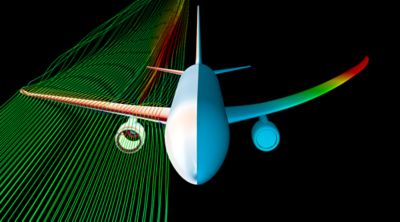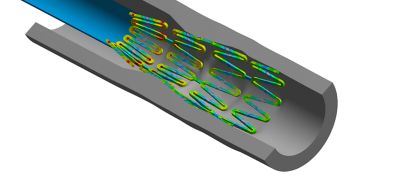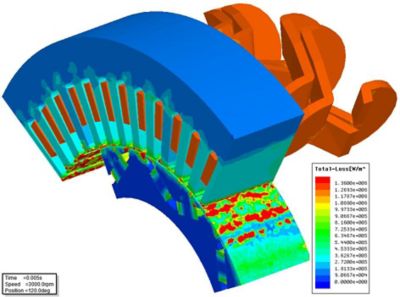-
United States -
United Kingdom -
India -
France -
Deutschland -
Italia -
日本 -
대한민국 -
中国 -
台灣
-
Ansys is committed to setting today's students up for success, by providing free simulation engineering software to students.
-
Ansys is committed to setting today's students up for success, by providing free simulation engineering software to students.
-
Ansys is committed to setting today's students up for success, by providing free simulation engineering software to students.
-
Contact Us -
Careers -
Students and Academic -
For United States and Canada
+1 844.462.6797
TOPIC DETAILS
What is Multiphysics?
In real life, physics don’t happen one at a time. Fluid, structural, thermal, and electromagnetic forces are constantly interacting. It’s where these domains collide that phenomena such as heat transfer, deformation, and mass transport occur.
Multiphysics is the analysis of the complex interactions between physical forces through computer simulation. By bringing individual physics solvers together into a single computational framework, multiphysics workflows help engineers accurately model the behavior of an entire system according to how physics happen in the real world — all at once.
Multiphysics models fill in the gaps where single-physics analyses are insufficient.

A small sample of applications that can be solved using multiphysics workflows.
Examples of Multiphysics
When more than one physic is interacting (such as fluids and structures, or structures and electromagnetics), they are said to be “coupled.” These interactions happen all around us all the time, from tapping the screens on our phones to driving our cars over bumpy roads. Common examples of multiphysics couplings include:
Fluid-structure Interaction (FSI):
Airplane safety: Modeling how airflow (fluid dynamics) affects the deformation and shock absorption (structural mechanics) of landing gear
Thermal-optics Coupling:
Heads-up displays (HUDs): Modeling how outdoor temperatures (thermal effects) affect the clarity of projected images in vehicles (optics)
Structural-acoustic Coupling:
Road noise: Modeling how aural feedback (acoustics) in vehicles is caused by tire-to-surface friction (structural mechanics)
Electromagnetic-thermal Coupling:
Power generation: Modeling how a motor’s energy fields (electromagnetics) produce heat (thermal dynamics) to optimize heat exchangers and fans
Engineering problems that require multiphysics analysis can be solved with different degrees of coupling.
If the physical problem involves a weak coupling of the physics — for example, when fluid forces create structural stress but do not deform the structure significantly — we can solve this with a one-way coupled analysis.
If there is strong coupling — for example, if the structure has a high deformation and affects the flow — then we need a two-way coupled solution.
Multiphysics Applications
Across industries, engineers rely on multiphysics solutions to help identify problems early in the design process, make informed decisions about optimizations, and ensure the safety and performance of their final products. Companies must be able to accurately predict how complex products will behave in real-world environments where multiple types of coupled physics interact.
Aerospace: Fluid-structure interaction analysis to determine optimal weight, shape, and structure of aircraft wings

Automotive: Simulating thermal expansion and deformations in headlamps to predict optical performance

Healthcare: Modeling interactions between human tissue and medical device structures such as implants and stents

Industrial: Reducing wear and tear on motors by identifying vibration sources through magnetic, structural, and acoustic analysis

Multiphysics Simulation
Multiphysics simulations make it possible to model complex, simultaneous interactions between multiple physics domains that cannot be easily studied experimentally due to cost, time, or safety constraints. These simulations deliver a deeper understanding of product performance by communicating and translating data across engineering disciplines.
Recent advancements in computer capacity, faster and more robust solvers, and improved methods for building workflows have accelerated the shift from single-physics simulations to comprehensive multiphysics simulations. This evolution enables engineers to better predict how their designs will function in the real world.
Advantages of Multiphysics Simulation
Realistic modeling: Accurately capture real-world scenarios where multiple physics domains interact simultaneously
System-level analysis: Gain insights into how physics couplings influence overall system performance
Time efficiency: Analyze entire systems at the same time, instead of in domain silos
Challenges of Multiphysics Simulation
Data congruency: Different physical domains have different timescales, spatial scales, and mesh resolutions
User expertise: Interpreting multiphysics simulations requires knowledge from experts across disciplines
Computational cost: The processing intensity of multiphysics simulations require significant resources and time
Multiphysics Analysis Tools
Typically, single solvers focus on specific physics areas such as structural mechanics, fluids dynamics, or electromagnetics. But some include self-contained multiphysics models. For example, in addition to solving for fluid dynamics, Ansys Fluent® fluid simulation software can also model acoustics, motion, solid heat transfer, and thermal stress. Single solvers with multiphysics capabilities are useful for analyzing couplings when models share geometry, meshes, and settings.
But as product complexity grows, single-physics simulations may no longer suffice.
This is where co-simulation becomes essential. By connecting specialized solvers, intricate interactions between different physical phenomena can be captured with greater precision. Tools like Ansys System Coupling™ physics solver connection software integrate all major solvers within a single interface. This means engineers can easily create high-fidelity, cross-domain models within a single, unified engineering environment.
Single-solver Multiphysics: Performs cross-domain analysis within one solver for a specific set of coupled physics equations. Provides simple setup in which interactions are tightly coupled.
System coupling multiphysics: Coordinates and exchanges data between specialized solvers in one computational framework. Provides greater flexibility in modeling complex situations that require coordination of independent solvers to capture the interactions between the physics models.
The Future of Multiphysics
There are several product development trends that are fueling the need for better application of multiphysics modeling, including sustainability and increased power density in chips and three-dimensional integrated circuits (3D-ICs). As companies innovate to increase power while reducing waste, multiphysics analysis will provide the holistic insights required to fully understand the interactions between physical phenomena within designs.
Related Resources
Let’s Get Started
If you're facing engineering challenges, our team is here to assist. With a wealth of experience and a commitment to innovation, we invite you to reach out to us. Let's collaborate to turn your engineering obstacles into opportunities for growth and success. Contact us today to start the conversation.











